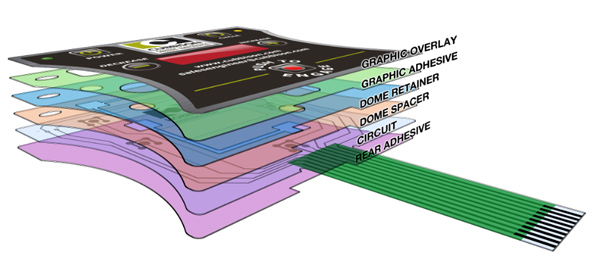Comprehending Membrane Switches Over: The Trick to Trusted and sturdy Controls

What Are Membrane Layer Switches?
Membrane layer buttons are an advanced remedy in the world of user interface innovation, incorporating functionality and layout seamlessly. These tools offer as a user interface in between customers and digital systems, integrating a number of components right into a small format. Usually constructed from versatile, slim layers of products, membrane layer switches are created to react to touch, making it possible for individuals to connect with machinery and electronic tools effectively.
The key components of a membrane switch consist of a printed circuit layer, graphic overlay, and a spacer layer that protects against unplanned activation. The graphic overlay can be personalized to reflect brand identification or individual preferences, boosting aesthetics while making certain usability. Membrane layer buttons are commonly made use of in different applications, consisting of clinical devices, consumer electronic devices, and commercial devices, owing to their toughness and resistance to ecological variables such as moisture and dust.
One of the crucial advantages of membrane switches is their capacity to endure wear and tear, making them excellent for high-traffic environments. Additionally, they are light-weight and call for marginal room, allowing for cutting-edge designs in product development. Generally, membrane layer switches stand for a sensible and efficient choice for modern digital user interfaces, marrying technology with user-centric layout principles.
Exactly How Membrane Switches Over Work
The procedure of membrane layer switches over joints on a basic yet effective system that converts user input right into electronic signals. When a user presses the switch, the leading layer deforms, enabling a conductive element in the circuit layer to make contact with a corresponding conductive pad on the bottom of the graphic overlay.
The layout of membrane layer buttons can vary, yet they usually incorporate domes or responsive elements to offer feedback to the individual, improving the overall experience - membrane switch. The products made use of in membrane layer switches, such as polyester or polycarbonate, contribute to their toughness and resistance to ecological variables, including moisture and dirt. The published circuits are typically encapsulated, which protects them from wear and tear over time.
Benefits of Membrane Layer Switches

In addition, membrane layer switches are known for their sturdiness. Built from durable products, they are immune to dirt, moisture, and physical wear, which significantly extends their life expectancy compared to standard mechanical buttons. This longevity makes them particularly suitable for high-traffic environments and applications requiring longevity.
Another significant advantage is the simplicity of cleaning and upkeep. The smooth surface area of membrane layer switches over decreases dirt buildup and is often unsusceptible spills, making them optimal for settings that need frequent sanitization.
Moreover, membrane buttons supply a structured account, causing a thinner design that can be integrated right into numerous gadgets without adding bulk. This feature not just improves the aesthetic appeal yet additionally adds to a much more ergonomic product layout.
Applications of Membrane Layer Switches
Versatile and straightforward, membrane switches locate applications across a variety of sectors, consisting of medical devices, customer electronics, and commercial devices. In the medical field, these buttons are essential to devices such as analysis equipment, person tracking systems, and infusion pumps, where integrity and simplicity of cleaning are important. Their try this website capability to preserve and withstand rough environments capability makes them optimal for such applications.

In customer electronics, membrane buttons are used in products like microwaves, washing machines, and push-button controls - membrane switch. Their streamlined design enables intuitive interface, boosting the overall customer experience while providing sturdiness and resistance to tear and wear
Industrial tools also benefits from membrane layer buttons, particularly in control panels for machinery and automation systems. These switches use defense against dirt and moisture, guaranteeing constant efficiency in tough environments. Additionally, their personalized features allow producers to tailor them to certain functional demands, boosting performance and performance.
Choosing the Right Membrane Layer Switch Over
When selecting a membrane switch, it is vital to think about different elements that influence performance and suitability for specific applications. The primary factors to consider consist of ecological conditions, tactile feedback, resilience, and design specifications.
First, more helpful hints assess the operating setting; buttons subjected to moisture, chemicals, or severe temperature levels need particular products to ensure long life and capability. Next, evaluate the need for responsive comments. Depending on customer communication, some applications may take advantage of a tactile feedback to verify activation, while others may favor a non-tactile style for aesthetic factors.
Toughness is one more crucial factor; membrane layer switches need to be developed to hold up against frequent usage, impacts, and abrasion. Make certain the chosen button can withstand the anticipated lifecycle, especially in high-usage scenarios.

Final Thought
In conclusion, membrane switches over serve as necessary parts in the style of trusted and resilient control systems throughout numerous industries. The flexibility of official website membrane layer switches over allows for customized remedies that meet particular operational requirements, enhancing their significance in modern innovation.
Membrane layer switches over stand for a crucial element of contemporary user interface layout, mixing capability with durability in various applications.Membrane layer buttons are an innovative service in the world of user interface technology, integrating performance and style flawlessly. Typically constructed from versatile, thin layers of materials, membrane switches are developed to respond to touch, making it possible for individuals to connect with equipment and digital gadgets successfully.
The style of membrane switches can differ, yet they commonly include domes or responsive aspects to supply comments to the user, enhancing the total experience.In verdict, membrane layer changes serve as important components in the design of sturdy and reliable control systems across various industries.